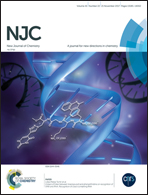Improving solubility and avoiding hygroscopicity of tetrahydroberberine by forming hydrochloride salts by introducing solvents: [HTHB]Cl, [HTHB]Cl·CH3OH and [HTHB]Cl·CH3COOH†
Abstract
With the aim to improve the solubility and dissolution rate of tetrahydroberberine (THB) by forming hydrochloride salts, three salts of THB, [HTHB]Cl (1), [HTHB]Cl·CH3OH (2) and [HTHB]Cl·CH3COOH (3), have been synthesized and characterized. The solubility and dissolution rate suggest that the maximum solubility values for 1–3 are approximately 98, 47, and 43 times as large as that of THB, and the dissolution rates of the three compounds are also effectively improved relative to THB. Surprisingly, the hygroscopicity of 2 and 3 has been efficiently reduced compared to that of 1, which shows that the hygroscopicity of the formed hydrochloride salts could be successfully avoided by introducing solvents into the structures. Preliminary analyses of the relationship between structures and properties indicate that the ability of the chloride ion to absorb water molecules (mainly through hydrogen-bond interaction) was reduced due to the presence of solvents in 2 and 3. This successfully implemented work may provide an inspirational method for avoiding hygroscopicity without compromising the solubility of hygroscopic APIs. Additionally, the three compounds show advantages in terms of antibacterial properties in comparison to their corresponding parent compounds.
![Graphical abstract: Improving solubility and avoiding hygroscopicity of tetrahydroberberine by forming hydrochloride salts by introducing solvents: [HTHB]Cl, [HTHB]Cl·CH3OH and [HTHB]Cl·CH3COOH](/en/Image/Get?imageInfo.ImageType=GA&imageInfo.ImageIdentifier.ManuscriptID=C7NJ02423A&imageInfo.ImageIdentifier.Year=2017)


 Please wait while we load your content...
Please wait while we load your content...